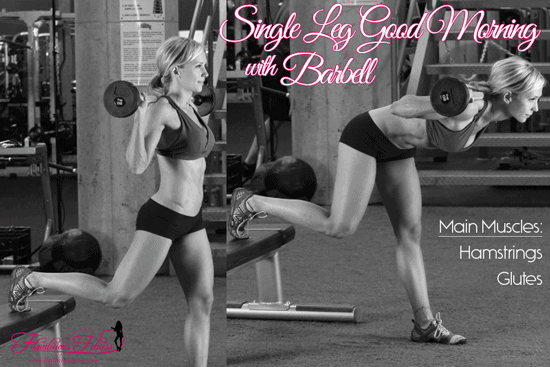 How To: Stand with barbell on shoulders. Use a weight that you are comfortable with. Lift right leg up and place on bench behind you. Keep a slight bend in your left leg as you bend forward at your torso. Repeat with other leg.
How To: Stand with barbell on shoulders. Use a weight that you are comfortable with. Lift right leg up and place on bench behind you. Keep a slight bend in your left leg as you bend forward at your torso. Repeat with other leg.
Main Muscles: Hamstrings & Glutes
Home Version:
What you will need: 2 dumbbells
How To: Stand with dumbbells in each hand. Lift your left leg, bending at the knee. Squat down with your right leg and lower the dumbbells down toward the ground. Keep your back straight and your core tight throughout movement. Repeat with other leg.
Why Women Have A Hard Time Toning Hamstrings
First lets chat about the functions of the hamstrings:
1) Knee Flexion: the motion of curling your leg back to touch your heel to your butt
2) Hip Extension: the motion of your thigh when you kick something behind you. In hip extension, the glutes should be doing most of the work with the hamstrings being their helper. If you have weak glutes, your hamstrings may take over.
The best exercises to shape your hamstrings are called multi-joint leg exercises or functional exercises. Functional exercises are similar to movements which we do on a daily basis, such as squats and lunges. These movements do not isolate specific muscles but use an entire muscle group, working all the muscles in your legs and helps to recruit more muscle mass, which helps to build more muscles.
This is a good thing because with more muscle mass comes an increase in metabolism, helping to burn fat, leaving only the beautiful muscle definition to be visible.
Functional exercises = burning more calories.
That’s why you will see a lot of functional exercise inside my Fat Loss shredding workout, Full-Body-Licious.
But There Is A Time For Isolation Exercises: Hamstrings to Quadriceps Ratio
For me and most females that I train, the hamstring to quadricep ration is imbalanced.
A balanced body will always be a more efficient body, another concept I teach inside Full-Body-Licious. At the very least, your hamstrings should be able to lift 75% of what your quadriceps can, with the exact number being debatable.
You can test the balance between the two muscle groups on the leg extension & leg curl machines. If you notice you can extend your leg with far more weight than you can when you flex or curl your leg, you may need to add more hamstring isolation exercises like the Barbell Good Mornings listed here. Alternatively, you can focus more on your hamstrings during all your leg exercises using squats, lunges and Romanian deadlifts.
Questions? Ask Below









I’m getting back in to my workouts and I’m trying to understand how the barbell good mornings work the hamstrings? This looks like a workout more for your back then your hamstring.
Hi Melissa! Although I am not one of Flavia’s employees, I am one of her readers and thought that some of my suggestions about how to do this exercise might help. At least that’s what I hope 🙂
What helps me when I am performing exercises like this is having a mind-muscle connection. I envision in my mind what muscle I am working so that I can stimulate that muscle more effectively and, in turn, get a better contraction of the working muscle.
When performing this specific exercise, or any exercise for that matter, I try to focus on not using momentum to perform the repetitions as this is neither an effective or safe method of training, especially if i am lifting a weight that is challenging (but still comfortable) for me. Instead of using momentum, I try to focus on putting tension on my working muscle and using the strength of that muscle to perform the repetions. More specifically, when performing this exercise, I suggest envisioning in my head that i am going to use my hamstrings and glutes to bend back up to the starting position. I try to place the tension on my hamstrings and glutes, using them to return to the starting position. Although it looks to me like one would have to engage their core and lower back during this exercise for stability purposes, I make sure that the strength needed to return back to the starting position is not coming from my back, core, and upper body. Instead, i make sure that it is coming from and originating in the hamstrings and glutes.
I suggest to refrain from arching your back as you bend forward at your torso because, in my experience at least, it has put unnecessary stress on my back and I used to use my back to pull my torso back up to the starting positron, which resulted in the emphasis being taken off of my hamstrings and glutes. In light of this, I suggest engaging and tightening the core to protect your back from injury. I also suggest making sure that your back remains straight throughout the movement.
I hope this helped 🙂
Awesome feedback and instructions Grayson, thank you! 🙂
All the best,
Anna, CPT, FF Specialist